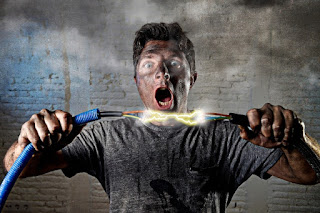Why a Homeowner Should Not Try to DIY
Save your time, save your home, save you fingers and toes—Don’t Try DIY
Google University has made experts of us all. A little Youtube, a little blog post from an “expert” and a smidge of message board, and you’ve got a handle on this home improvement thing. But knowing is only half the battle. The other important half is doing it right so that you don’t die, get maimed, maim others, or destroy the world around you in a fiery inferno.
Home Repair Detoit
We’re caught up in a DIY love affair right now. Well presented shows that cut out eight weeks of DIY hell and mash it down to half of an hour, then package it with pretty people who somehow don’t totally come off as the sleep deprived, grime coated, stressed out messes they actually are—gives the illusion that DIY is fun, fast, and cost effective—probably has something to do with it.
I’m not saying you shouldn’t swap out an old light fixture for an updated one (kill the circuit breaker!) or that painting a small room in your house a fun, new color has to be hired out, but there are definitely projects best left to the pros. Unless you, at worst, have a death wish or, at best, want to give your best try at storytelling to your insurance adjuster.
Don’t try this at home, folks!
1. Electrical—don’t extend circuits or run new cable! I don’t care how smart you are. There are professionals that do this for a reason. If you try to mess with the electrical in your home to this extent, you’ll be rewarded with one of two outcomes: a new crispier you because you died from massive electrical shock, or you set a fire, possibly to yourself, but certainly your home and beloved pets ablaze. If dying doesn’t faze you, well, the code inspector can be a downright unpleasant person to deal with too. Most cities and townships strictly govern electrical work, and it must follow code.
2. Plumbing—don’t touch your home’s water supply! Leave your home’s pipes alone. Don’t try to modify or expand the lines or hot water system. Yet again, you’ve set yourself up for a fire by misusing a blowtorch, or maybe just a flood when a torrent of unstoppable water comes gushing through. Even if the initial fix doesn’t seem to end in doom of biblical proportions, it doesn’t mean something isn’t going wrong behind the scenes. Even a little leak can cause epic damage if it goes unnoticed even for a short while. Never DIY in concealed areas such as behind walls, in ceilings, under floors or anywhere you can’t easily see. If it begins leaking and you don’t know it . . . your home and bank accout is in trouble .
3. Tree Cutting—well, it’s really dangerous! Chainsaws, axes, and soft human flesh don’t mix very well. Plus, let’s say you do keep yourself intact, there are still all the other cars, houses, utility poles, and people that could get squashed in the process of a tree getting cut down. It’s probably safe to do if it’s a small tree that’s smaller than 4” in diameter and less than 20’ tall, but still be mindful of what’s around you and of all of your fingers.
4. Removing Walls—your roof is now your dining room floor. Load bearing walls are real and really important. Start swinging a sledge hammer without a consultation from a building engineer, and you’ll find your home a level less than it was before. It may not be a dramatic crashing of a floor that happens at once, but if you remove a load bearing wall, it will come down eventually overtime. And, again with codes and permits. Many towns will not grant the proper permit to remove a wall in your home without a sign-off of a building engineer.This definatnly a job for a contractor.
5. Roofing—you can’t fly, only fall 20-ish feet. One slip and you could be looking at a serious injury. It takes skill to juggle the equipment needed to install weather proof systems like the flashing and vents. Dragging all that’s needed to do a roofing job up to a serious height, and add in a scary pitch, and you’re just begging for a trip to the hospital or worse if you don’t know exactly what you are doing at all times.
DIY Fail for Roofing
People don’t realize that DIY is often harder than it looks. It’s not arts & crafts. We’re not talking cork picture frames from your old wine bottles (not judging your wine consumption ;). Despite hours of videos to prepare you, you still might not have the know-how once you undertake the task. Costly mistakes can be made or you can run into problems you didn’t anticipate that are clearly over you ability level, leaving you to hire a contractor anyway.
Having the proper tools for the project is obviously important to getting things done right. A contractor or handyman will have what he needs and then some. He or she will also have the connection to other pros in other fields should he or she need a hand with something outside his or her expertise. Chances are you don’t have much beyond the basics and would have to rent the rest, and then there’s the learning curve with getting to know how to use the tools so that you don’t chop off limbs or mangle your home. The home improvement professionals have the edge here for sure.
Finally, a pro will just get the project done fast. Period. Spend your weekends with your friends and family—not on dismantling and reassembling your home slowly and painfully. Practice makes perfect—contractors and other pros know how to avoid mistakes and years of practice make for a speedy turnover on a job.
So, are you thinking of switching out some old faucets or a simple light fixture? Sure, give it a try, but keep a handyman’s number on hand. Wanna knock down a wall to make room for baby? Ermm . . . Better call a home improvement pro. Remember, there's no shame in asking a plumber, electrician, roofer, HVAC or any other service pro to help out your home with repairs, maintenance, and renovations. Connect with a pro to make sure your projects go well!





Comments
Post a Comment